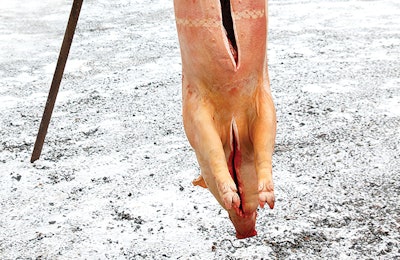
It is of major benefit to the pig, the producer and the processor that we get fasting times correct. This is a very serious issue on several fronts, and if you as a producer are guilty of sub-optimum fasting times, it may just be worth your while reading on.
The fasting period pre-slaughter in pigs still appears to be an area where producers could be losing money. The common perception is to ensure that pigs will not lose weight prior to slaughter at the expense of over-feeding animals. I thought it might be worth highlighting some research carried out previously in this area to show where some producers might be losing out.
The common perception is to ensure that pigs will not lose weight prior to slaughter at the expense of over-feeding animals.
Under-fasting
In this scenario, pigs are arriving for slaughter havingf consumed food in the last 10 to 14 hours. Taking gut transit times into account, it is fair to say that any feed supplied within this timeframe is wasted and will never be utilized by the animal for growth. At today’s prices, with finisher feedstuff averaging €270 per metric ton, this is one area where some producers are literally throwing money down the drain. If you take a finishing pig on a wet feed system that receives one kilo of feed on a fresh weight basis within 12 hours of slaughter and utilizes none of this feed for growth or reducing weight loss, this can result in a loss of 27 cents per pig (€7,000 per year on a 1,000 sow unit). It will also have the compounding affect of seriously distorting your kill-out percentage and increasing stress amongst pigs in transit.
Optimum fasting
In this case, a pig should arrive at the factory without having endured any extra stressing associated with fasting, should not have lost weight due to fasting and should have a minimal level of feedstuff in their gut. This can be achieved by ensuring the pig was last fed no sooner than 14 to18 hours prior to slaughter, with about 16 hours being the optimum interval. This ensures that there is minimal risk of any contamination or spoilage to the carcass during processing by reducing the risk of gut puncture resulting in partial or full carcass condemnation events.
Over-fasting
Over-fasting of pigs will result in higher stress levels for the animals and higher incidence of aggressive behavior, which will bring about their own problems in sale weight pigs. An overview of the research shows that it is well established that pigs fasted for more than 18 hours lose carcass weight. At about 24 hours fasting, a decrease of 0.6 kg of carcass weight can result. This would equate to almost 1 euro per pig at today’s prices or almost €24,000 per year on a 1,000 sow unit.
There are many reasons for withholding feed prior to transport to the abattoir; these include reduced deaths in transport, pig welfare, meat quality and food safety. The latter is one of the biggest reasons and is very important in the control of Salmonella and other microbial pathogens. Should a very full stomach be perforated during the dressing process, it could contaminate and spoil the carcass.
It is important that each producer is aware of how long their pigs are travelling to the factory and how much time they are spending in the lairage prior to slaughter so they can adjust their final feeding time for pigs beforehand. This will ensure that pig weight loss is minimized while feed wastage and pig stress is kept to an absolute minimum also. Remember, routines are very important in any part of life and even more so in pig production, but they must never become habits!
By special permission of Amy Quinn, Editor, Teagasc Advisory Newsletter

















